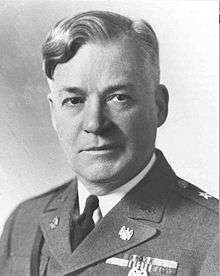William G. Everson
William Graham Everson (July 1, 1879 – September 13, 1954) was a Major General in the United States Army who served as Chief of the National Guard Bureau.
William Graham Everson | |
|---|---|
 General Everson as National Guard Bureau Chief | |
| Born | July 1, 1879 Wooster, Ohio |
| Died | September 13, 1954 (aged 75) Portland, Oregon |
| Buried | Riverview Abbey, Portland Oregon |
| Allegiance | |
| Service/ | |
| Years of service | 1898–1945 |
| Rank | |
| Unit | Indiana Army National Guard National Guard Bureau |
| Commands held | 332nd Infantry Regiment 76th Infantry Brigade Indiana Army National Guard Chief of the National Guard Bureau |
| Battles/wars | Spanish–American War World War I
|
| Other work | Baptist clergyman Public speaker College president |
Early life
William Graham Everson was born in Wooster, Ohio on July 1, 1879. He was raised in Indiana, and joined the Army for the Spanish–American War, enlisting in Company E, 158th Indiana Infantry, and rising through the ranks to First Sergeant.[1][2]
Subsequent career
Everson received his ordination as a Baptist minister in 1901, and was the pastor of churches in Boston, Indianapolis, Louisville, Cincinnati and Muncie. He also became a well known public speaker as a lecturer on the Chautauqua Circuit.[3]
In 1903 Everson graduated from Franklin College, and in 1905 he was commissioned in the Indiana National Guard as a First Lieutenant in the Chaplain Corps.[4][5] In 1908 Everson graduated from Newton Theological Seminary.[6][7] He was promoted to Captain in the 3rd Indiana Infantry in 1909, Major in 1914 and Lieutenant Colonel in 1918.[8]
World War I
Everson was promoted to Colonel and commander of the 332nd Infantry Regiment, a unit of the 83rd Infantry Division.[9] The 332nd served in Italy, and were the only American troops to serve east of the Adriatic Sea, carrying out operations in Austria, Dalmatia, Serbia, and Montenegro.[10]
The awards and decorations Everson received for his World War I service included: War Merit Cross (Italy); Italian Sanctus Georgius (Saint George), Silver (for valor); Fatiche di Guerra (Italy) (for soldiers who served in the war zone for one year or more); Duca D'Aosta Medal (Italy) (for soldiers who served in or with the Italian Third Army); and the Star and Crown of Fiume (for defense of the Free State of Fiume).[11]
Post World War I
Everson continued his military service after the war. In 1922 he was promoted to Brigadier General as commander of the 76th Infantry Brigade.[12] Everson subsequently served as Adjutant General of Indiana.[13]
He graduated from the United States Army War College in 1923 and the United States Army Command and General Staff College in 1928.[14]
National Guard Bureau
In 1929 Everson was promoted to Major General and appointed as Chief of the Militia Bureau.[15] He served in this position until 1931, when he resigned in order to return to the ministry, accepting a position with the First Baptist Church in Denver.[16]
Later career
In 1931 Everson received an honorary Doctor of Divinity degree from Franklin College.[17] From 1939 to 1943 he served as President of Linfield College.[18] Everson continued to serve in the military until reaching mandatory retirement age in 1945.[19]
Retirement and death
In retirement Everson resided in Portland, Oregon, where he died on September 13, 1954. He is buried at Riverview Abbey in Portland.[20]
References
- United Spanish War Veterans, Department of Indiana, General Orders, 1937
- Hyacinthe Ringrose, The International Blue Book, 1926, page 130
- Frank D. Haimbaugh, History of Delaware County, Biography, William G. Everson, 1924
- International Herald Tribune, The Front Page, 1887-1992, 1992, page 62
- Oregon Guardsman, The New Chief, November 15, 1929, page 1
- Newton Theological Institution, Bulletin - The Newton Theological Institution, Volumes 1–2, 1906, page 13
- Andover Newton Theological School, Annual Catalog, 1912, page 262
- U.S. Army Adjutant General, Recruiting News, The Chief of the Militia Bureau, February 1, 1931
- Matthew J. Seelinger, Army Historical Foundation, "Viva l'America!" The 332d Infantry on the Italian Front, 2013
- Joseph L. Lettau, In Italy with the 332nd Infantry, 1921, page 62
- Levere, William C. (1928). The History of Sigma Alpha Epsilon in the World War. Menasha, Wisconsin: The Collegiate Press: George Banta Publishing Co. p. 152.
- Army-Navy Publications, Pictorial History Thirty-Eighth Division, 1941, page 137
- O. K. Quivey, Sigma Alpha Epsilon Fraternity, The Record, Fighting Parson Made Prexy, Volume 58, Issue 4, 1938, page 384
- Oregon Guardsman, The New Chief, November 15, 1929, page 1
- Chicago Tribune, New Militia Bureau Chief Here, February 9, 1930
- Ralph Albert Parlette, The Lyceum Magazine, Volume 41, 1931, page 11
- Honolulu Star-Bulletin, Pan-Pacific Who's Who, 1941, page 209
- Christian Century Company, The Christian Century, Volume 60, 1943, page 305
- William R. Denslow, 10,000 Famous Freemasons, Part One (A–J), 2004, page 30
- Thomas E. Spencer, Where They're Buried, 2009, page 543
External references
William Graham Everson at Find A Grave
| Military offices | ||
|---|---|---|
| Preceded by Ernest R. Redmond (acting) |
Chief of the National Guard Bureau 1929–1931 |
Succeeded by George E. Leach |